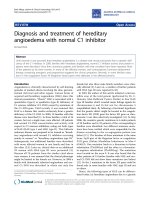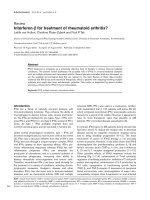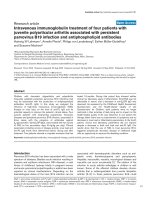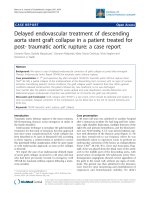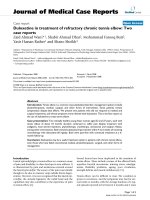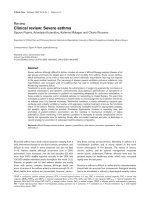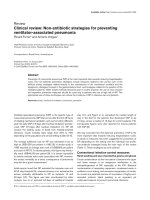Báo cáo y học: "Clinical review: Treatment of heat stroke: should dantrolene be considered" doc
Bạn đang xem bản rút gọn của tài liệu. Xem và tải ngay bản đầy đủ của tài liệu tại đây (56.78 KB, 6 trang )
86
CHS = classic heat stroke; CNS = central nervous system; EHS = exertional heat stroke; HS = heat stroke; MH = malignant hyperthermia; NMS =
neuroleptic malignant syndrome.
Critical Care February 2005 Vol 9 No 1 Hadad et al.
Introduction
Hyperthermia is defined as any core temperature rise to
above the hypothalamic set-point at which heat-dissipating
mechanisms are impaired. Normal core temperature values
are in the 36.5–37.5°C range at rest and can rise to 40°C
during strenous exercise. Hyperthermia is usually caused by
an imbalance between total heat (metabolic and environ-
mental heat) accumulated and total heat lost from the body.
Hyperthermia per se may be physiological and can be
compensated for (as in the moderate elevation in core
temperature that occurs in an exercising and otherwise
asymptomatic individual), or it may be pathophysiological but
generally well tolerated. It may also be associated with
adverse pathophysiological consequences such as inability to
continue physical exertion (heat exhaustion). At the extreme,
hyperthermia represents a state in which the elevation in core
temperature is either already accompanied by organ injury or
is sufficient to produce such injury if left untreated.
Several syndromes have been reported to be associated with
extreme hyperthermia, including malignant hyperthermia
(MH), neuroleptic malignant syndrome (NMS) and heat stroke
(HS). The mainstay of treatment of these syndromes includes
the administration of basic resuscitative measures together
with simultaneous cooling aimed at reducing body
temperature [1,2]. Cooling may be achieved by several
methods, such as immersion in cold water and evaporation of
water over the skin [3–7]. Because heat is primarily produced
by hyperactivity of muscles in the various syndromes,
dantrolene sodium, a muscle relaxant, has also been
suggested to accelerate cooling [8–10]. In MH, dantrolene
administration resulted in a rapid reduction in mortality rate,
and therefore it is now considered an essential part of
treatment in this syndrome [11–13]. Dantrolene has also
been recommended for the treatment of NMS [14]. To date,
no drug has shown significant efficacy in improving the
outcome of patients with HS.
Review
Clinical review: Treatment of heat stroke: should dantrolene be
considered?
Eran Hadad
1
, Yoav Cohen-Sivan
1
, Yuval Heled
1
and Yoram Epstein
2
1
Heller Institute of Medical Research, Sheba Medical Center, Tel Hashomer, Israel
2
Heller Institute of Medical Research, Sheba Medical Center, Tel Hashomer, and the Sackler Faculty of Medicine, Tel-Aviv University, Tel-Aviv, Israel
Corresponding author: Yoram Epstein,
Published online: 11 August 2004 Critical Care 2005, 9:86-91 (DOI 10.1186/cc2923)
This article is online at />© 2004 BioMed Central Ltd
See Commentary, page 23
Abstract
Rapid and efficient cooling is the most important therapeutic objective in patients with heat stroke (HS).
This article reviews the mechanism of action and rationale for the use of dantrolene as a potential
supportive cooling method in the treatment of HS. Relevant studies were included to support discussion
of the role of dantrolene for the treatment of HS. In some studies dantrolene was shown to accelerate
cooling rate when administered after the development of exertional HS. Dantrolene was also found to be
effective in reducing the extent of HS signs when given as pretreatment in an animal model.
Accumulated data do not support the routine use of dantrolene as an adjuvant cooling technique in HS,
but administration of this drug in severe cases, or in which no improvement is observed, appears
rational. Further trials are needed in order to assess the true effectiveness of dantrolene in HS.
Keywords cooling, dantrolene, exertional heat stroke, heat stroke, hyperthermia, temperature
87
Available online />Experience with dantrolene use in HS is in its initial phases
(Tables 1–3). In some studies a possible benefit from
dantrolene treatment was reported, whereas in others it was
not found to be effective [15–22]. We reviewed relevant
studies concerning dantrolene use in HS in order to establish
its role in the treatment of this condition.
Studies included in this review were identified by means of a
comprehensive Medline search, limited to the English
language literature, using the following keywords: ‘dantrolene’
and ‘hyperthermia’ or ‘heat’. Each article identified was further
examined for relevancy.
Dantrolene
Dantrolene sodium is a hydantoin derivative. It acts directly on
muscle contractile elements, attenuating the amount of
calcium released from the sarcoplasmic reticulum of skeletal
muscle to the cytosol [23–25]. As a result, calcium
dependent excitation–contraction coupling and consequent
muscle contraction are inhibited.
The mean biological half-life of dantrolene in healthy volunteers
or patients was reported to range from 6 to 9 hours, with
extremes of 3 and 22 hours [25–30]. It is primarily metabolized
in the liver, with 15–25% of the dose administered being
excreted by the kidneys [27,29,30]. Dantrolene is marketed as
Dantrium (Norwich Eaton Pharmaceuticals, Norwich, NY, USA)
and can be administered intravenously (in solution with
mannitol and sodium hydroxide) or orally.
When dantrolene is used as an emergency therapy, such as
in acute hyperthermic syndromes, it is unlikely to cause major
adverse effects [25]. However, prolonged use may be
associated with undesirable side effects that include
weakness, drowsiness, diarrhea and malaise [25].
Hepatotoxicity, which can be irreversible, is also a major
concern. The risk for hepatic injury appears to be about
twofold greater in females, in patients receiving doses over
300 mg/day and in those treated for over 60 days [31]. In
addition, dantrolene sodium solution is highly alkaline
(pH 9.6), and intravenous injection may cause extravasation
and tissue necrosis [25].
Heat stroke and ‘thermic stress syndrome’
HS is a life-threatening illness characterized by an elevation in
core body temperature to above 40°C with central nervous
system (CNS) dysfunction that results in delirium,
convulsions, or coma [32,33] in the absence of any other
cause of CNS dysfunction, and skin dryness. The affected
individual may suffer from a characteristic multiple organ
clinical and pathological syndrome caused by temperature-
induced tissue damage [1,34]. HS results from exposure to a
high environmental temperature, in which case it is called
‘classic’ heat stroke (CHS; or ‘nonexertional’ HS), or from
strenuous exercise, in which case it is called ‘exertional’ heat
stroke (EHS) [34–36]. CHS is usually seen in the very young
or elderly and in poor socioeconomic settings with limited
access to air conditioning. EHS is seen more commonly in
exercising individuals, for instance soldiers in army training.
Further reviews on HS are available [32,33,34–36].
Epidemiological incidence data for HS are imprecise
because of varying definitions of heat-related death and
under-diagnosis [35]. One study conducted in urban USA
found a variation from 17.6 to 26.5 cases per 100,000
capita. Data from Saudi Arabia show a seasonal incidence
pattern, ranging from 22 to 250 cases per 100,000 capita.
The crude mortality rate in Saudi Arabia has been estimated
at 50%. Treatment consists of immediate cooling and
support of organ system function.
Some authors believe that HS, as well as MH and other
hyperthermic syndromes, are different manifestations of a
broader underlying condition called ‘thermic stress syndrome’
[9,10,15,17,37]. This common malady, which is triggered by
different mechanisms, is characterized by an extreme
elevation in body temperature and CNS dysfunction, which
may be complicated by bleeding diathesis, elevated serum
enzyme levels and renal failure. Because dantrolene was
found to be effective in the treatment of MH and NMS, its
usage has also been recommended for the treatment of HS
[8–10,15].
Dantrolene use in heat stroke
Two reports from the early 1980s demonstrated a beneficial
effect from using dantrolene in HS. Lydiatt and Hill [15]
reported on a patient with EHS who responded favourably to
dantrolene (4 mg/kg intravenously) after symptomatic therapy
had failed. In a case report, Denborough [8] reported that
intravenous dantrolene (20 mg bolus) therapy produced rapid
recovery in a young soldier suffering from EHS after a march.
In a controlled study, the adjuvant effects of dantrolene in
comparison with passive cooling were investigated in a
canine model of CHS [16]. Intravenous administration of
dantrolene (5 mg/kg) did not significantly improve cooling
rates, haemodynamic parameters, pathological changes, or
clinical outcome when compared with passive cooling.
Channa and coworkers [17] conducted a study in which 20
EHS patients were randomly assigned to two groups with
only one group receiving dantrolene (2.45 mg/kg intra-
venously). Patients in both groups were cooled either using
the Makkah body cooling unit or by ‘conventional methods’,
namely spraying of tap water over the patients while fanning.
Cooling rates were found to be significantly higher in the
dantrolene group. All patients survived and there was no
difference in the incidence of neurological sequelae between
the groups.
The effects of dantrolene were also evaluated in 53 patients
suffering from CHS [21]. All patients were treated by using a
88
Critical Care February 2005 Vol 9 No 1 Hadad et al.
Table 1
Summary of studies of dantrolene treatment of heat stroke in humans
Numbers included
Dantrolene Dantrolene
treatment Control dose
Reference Study type Setting arms arms (mg/kg bw) Improved parameters Nonimproved parameters
[21] Randomized, double-blind, Patients with classic 26 26 2 – Cooling rate, mean number of
controlled heat stroke hospital stays
[17] Randomized controlled Heat stroke patient 8 12 2–4 Cooling rate Survival, neurological sequelae
bw, Body weight.
Table 2
Summary of studies of dantrolene treatment of heat stroke in animals
Dantrolene
Numbers dose
Reference Study type Model included (mg/kg bw) Improved parameters Nonimproved parameters
[18] Randomized controlled Exercising rats 7 140 Cooling rate –
Nonexercising rats 7 140 – Cooling rate
[19] Randomized controlled Nonexercising piglets 4 3 Cooling rate
a
Cardivascular parameters
[16] Randomized controlled Nonexercising dogs 5 5 – Cooling rate, haemodynamic
parameters, pathological
changes, clinical outcome
a
Improvement was reported with or without mannitol. bw, Body weight
Table 3
Summary of studies of dantrolene pretreatment of heat stroke in animals
Numbers included
Dantrolene Dantrolene
treatment Control dose
Reference Study type Model arms arms (mg/kg bw) Improved parameters Nonimproved parameters
[20] Randomized controlled Exercising sheep 6 6 1.5–3 Body temperature, severity of –
heat stroke signs, changes in
serum enzymes and hormones,
survival
a
–
[18] Randomized controlled Exercising rats 7 7 140 – Physical capacity
Nonexercising rats 7 7 140 Endurance in the heat –
a
Trend only. bw, Body weight.
89
body cooling unit in which atomized water was sprayed over
the victim while they were fanned with hot air. In addition,
treatment with either dantrolene (2 mg/kg) or placebo was
given intravenously after blind, randomized selection.
Dantrolene administration did not result in any enhancement
of the cooling rate, and there was no significant difference in
the number of hospital stays between the two groups. It
should be noted that in this study both treatment groups
achieved satisfactory cooling in under 1 hour. Therefore, a
possible positive effect of dantrolene in extreme cases of HS,
in which cooling times might be longer, cannot be ruled out. It
should further be noted that in this study Bouchama and
coworkers [21] treated their patients with dantrolene and
mannitol simultaneously. Thus, it could not be concluded
whether the reported positive effects were attributed to
dantrolene or to mannitol.
Mannitol may be beneficial in the setting of HS because of its
effect on expanding the intravascular volume and reducing
tissue injury after ischemia by scavenging oxygen free
radicals [38,39]. In order to address this question,
Zuckerman and coworkers [19] designed a randomized
controlled study in which heat stroked piglets were treated by
one of the following four methods: passive cooling,
‘conventional cooling’ (intravenous fluid resuscitation,
sponging with tap water, mechanical fanning and ice gastric
lavage), conventional cooling along with dantrolene, and
conventional cooling along with mannitol. Although
dantrolene significantly shortened the cooling time when
compared with conventional cooling, it did not shorten the
cooling time when compared with mannitol. Moreover, it was
shown that dantrolene did not improve cardiovascular
parameters when administered in addition to conventional
methods.
Tayeb and Marzouki [20] investigated whether dantrolene
might be advantageous in prophylaxis against HS in
exercising sheep. They found that pretreatment with
dantrolene (3 mg/kg and 1.5 mg/kg intravenously) caused a
significant reduction in body temperature, and decreased the
extent of HS signs as well as some of the induced changes
in enzymes and hormones. These effects were more
significant in the group receiving dantrolene 3 mg/kg than in
the group receiving 1.5 mg/kg. The dantrolene group also
exhibited a trend toward reduced mortality from HS (0/12) in
comparison with the group that did not receive dantrolene
treatment (2/6).
Using a rat model of EHS and CHS, Moran and coworkers
[18] studied the efficacy of dantrolene both as a prophylactic
agent and as a therapeutic drug. Administration of high doses
of dantrolene (140 mg/kg intravenously) before heat stress
delayed the development of HS in the sedentary animals.
Estimated temperatures were lower in the exercising rats that
received Dantrolene pretreatment, but this was most
reasonably attributed to the limited physical capacity induced
by dantrolene. When dantrolene, at the same dose, was
administered after the development of HS, it significantly
improved the cooling rate in the exercising rats – an effect
that was not seen in the sedentary group.
Discussion
The rationale for the use of dantrolene in HS emerged from
the overlap in the systemic manifestations of HS and other
hyperthermic syndromes, particularly MH. However, some
researchers claimed that, although hyperthermia was
characteristic of both MH and HS, these syndromes
represent two clinical entities with different heat generating
cellular mechanisms. Although MH is characterized by
muscular rigidity, which causes active heat production, HS
usually manifests in the form of flaccidity, and heat production
does not continue uncontrolled [17,40]. Therefore,
dantrolene, which uncouples the excitation–contraction
sequence heat generating mechanism, may not be beneficial
in the treatment of HS. Moreover, MH is a genetically
transmitted disease, which is triggered by several
depolarizing muscle relaxants or volatile anaesthetic agents
[41,42]. In comparison, to the best of our knowledge, no
genetic predisposition has been definitely incriminated in the
typical HS patient.
However, several reports suggest a possible link between HS
and MH. Tobin and coworkers [43] reported a case of fatal
HS in a patient who experienced MH 8 years earlier and
speculated whether other HS victims are MH susceptible. An
abnormal caffeine–halothene contracture test, which is
considered indicative for MH susceptibility, was found in
more than 40% of individuals who survived EHS, whereas
less than 1% of the general population exhibited this
response [44]. It is important to note that adequate recovery
time must be given before performing such tests after a bout
of rhabdomyolysis. Muscle function takes considerable time
to recover and, inferentially at least, so does muscle
metabolism. Therefore, care must be taken before relying on
post-HS muscle contracture tests. A possible underlying
myopathy in EHS patients was demonstrated by Bendahan
and coworkers [45], who found abnormal muscle energetics
in such patients by using a
31
P magnetic resonance
spectroscopy. Therefore, there is some evidence to suggest
that a subset of individuals with HS may also be predisposed
to MH. Theoretically, this subset of individuals might continue
to have a relatively high level of heat production even after
collapse. They may also be at increased risk for EHS because
an attenuated muscular efficiency can increase muscular
caloric production at the same absolute work intensity. The
fact that some individuals with HS might have a contribution
of MH-type pathophysiology might also explain why there has
been anecdotal evidence suggesting a possible benefit from
dantrolene in selected cases.
The above studies indicate that the cooling rate was the only
parameter among those evaluated that improved when
Available online />90
dantrolene was administered after the development of HS
[17–19]. However, this effect was not demonstrated in all
studies. The diversity of results may be accounted for by the
models investigated. When dantrolene was administered in
an exercising model, it was found to be more effective than in
a CHS model. This is not surprising because dantrolene
inhibits muscle contraction, which does not play a role in the
pathophysiology of CHS.
Collectively, most of the studies suggest that dantrolene is
not beneficial in reducing mortality rate when it is given for
the treatment of HS. However, survival rates in EHS currently
approach 95%, and the studies were not large enough to
exhibit a reduced mortality [1,46]. Moreover, some reports
suggest that dantrolene may even prevent death in cases of
severe HS [15,17]. For example, one patient in the study
conducted by Channa and coworkers [17] who received
dantrolene made a complete recovery in spite of an initial
core temperature of 44°C. An EHS patient described by
Lydiatt and Hill [15] had a rectal temperature of 42°C for
more than 30 min and responded only to dantrolene.
Noteworthy, the authors did not state the upper recording
limit of their thermometer. If a clinical thermometer has an
upper limit of 42°C, then it will record 42°C when the actual
temperature is 46°C. Despite successful cooling for 30 min,
the thermometer still shows 42°C even though the
temperature has been reduced by 4°C. Taking dantrolene at
this instant will lead to an impressive, albeit misinterpreted,
result.
Some researchers indicated that the relative ineffectiveness
of dantrolene in some of the studies may be related to an
inadequate dose [21,47]. Dantrolene was administered in
doses of 2–5 mg/kg, which were selected according to
recommended protocols with regard to the use of this agent
in MH. However, the optimal dose of dantrolene in MH is still
questionable. Although Britt [48] reported a complete
recovery from MH when dantrolene was used at a dose of
6 mg/kg, others [31] postulated that an increased dose of
dantrolene may be associated with hepatotoxicity. The risk for
hepatotoxicity is even more concrete in HS patients because
the liver is commonly injured in HS and increasing the dose of
dantrolene may worsen this hepatic damage. Nevertheless,
hepatotoxicity has never been reported in HS victims who
received dantrolene.
Despite the absence of outcome-based data, it might
nevertheless be pathophysiologically rational to try dantrolene
in selected cases. Dantrolene may be beneficial where there
is evidence of ongoing excessive heat production, such as in
cases of HS that are accompanied by muscular rigidity. In
these cases, the apparent HS may be misdiagnosed, and the
patient may actually be suffering from MH or NMS. Finally,
dantrolene might also have a role to play in limiting muscle
injury and its consequences in rhabdomyolysis by impairing
calcium release from the sarcoplasmic reticulum [49,50].
Loss of calcium homeostasis in muscle cells may be
associated with muscle injury resulting from impairment in
mitochondrial respiration and ATP production, activation of
phospholipase A
2
with production of leukotrienes and
prostaglandins, increased production of free radicals, and
activation of calcium-activated proteases [49]. Although there
is no evidence that dantrolene reduces the extent of muscle
injury in EHS, it was found to protect against muscle injury
associated with exercise in several studies [51–54].
Dantrolene pretreatment reduced the severity of HS signs in
an exercising animal model. This effect may be attributed to
decreased muscular production of metabolic heat or to an
unknown modulation of neurotransmitter release [20].
However, the effect of dantrolene on muscle contracture may
result in limited physical capacity. Furthermore, the
administration of dantrolene before HS is more theoretical
than real because the incidence of EHS is negligible in
comparison with the number of individuals who are engaged
in physical activity and/or are exposed to heat strain.
Conclusion
Therapy with the accepted MH prophylactic dose of
2–5 mg/kg resulted in a possible benefit from dantrolene
treatment in HS in some studies, whereas in others it was not
found to be effective. The limited literature does not support
the routine use of dantrolene as an adjuvant cooling
technique in the setting of HS. Nevertheless, because
dantrolene does appear to increase cooling rate, furthur
studies are advised for dantrolene use in severe cases or
cases in which no improvement is observed with other
cooling methods. Wider trials are still needed to evaluate the
efficacy of dantrolene in reducing mortality, thereby justifying
its use in HS. Noteworthy, dantrolene should not be used as
a single cooling method, and its administration should only be
in addition to the well established ‘conventional methods’.
Competing interests
The author(s) declare that they have no competing interests.
References
1. Epstein Y, Sohar E, Shapiro Y: Exertional heat stroke: a pre-
ventable condition. Isr J Med Sci 1995, 31:454-462.
2. Chan TC, Evans SD, Clark RF: Drug-induced hyperthermia. Crit
Care Clin 1997, 13:785-808.
3. Wyndham CH, Strydom NB, Cooke HM: Methods of cooling
subjects with hyperpyrexia. J Appl Physiol 1959, 14:771-776.
4. Weiner JS, Khogali M: A physiological body-cooling unit for
treatment of heat stroke. Lancet 1980, 1:507-509.
5. Al-Aska AK, Abu-Aisha H, Yaqub B, Al-Harthy SS, Sallam A: Sim-
plified cooling bed for heatstroke [letter]. Lancet 1987, 1:381.
6. Armstrong LE, Crago AE, Adams R, Roberts WO, Maresh CM:
Whole-body cooling of hyperthermic runners: comparison of
two field therapies. Am J Emerg Med 1996, 14:355-358.
7. Costrini A: Emergency treatment of exertional heatstroke and
comparison of whole body cooling techniques. Med Sci Sports
Exerc 1990, 22:15-18.
8. Denborough MA: Heat stroke and malignant hyperpyrexia. Med
J Aust 1982, 1:204-205.
9. Meyers EF, Meyers RW: Thermic stress syndrome. JAMA 1982,
247:2098-2099.
Critical Care February 2005 Vol 9 No 1 Hadad et al.
91
Available online />10. Meyers EF: Thermic stress syndrome. Prev Med 1979, 8:520-
522.
11. Kozack JK, MacIntyre DL: Malignant hyperthermia. Phys Ther
2001, 81:945-951.
12. Wedel DJ, Quinlan JG, Iaizzo PA: Clinical effects of intra-
venously administered dantrolene. Mayo Clin Proc 1995, 70:
241-246.
13. Strazis KP, Fox AW: Malignant hyperthermia: a review of pub-
lished cases. Anesth Analg 1993, 77:297-304.
14. Persing JS: Neuroleptic malignant syndrome: an overview. S D
J Med 1994, 47:51-55.
15. Lydiatt JS, Hill GE: Treatment of heat stroke with dantrolene.
JAMA 1981, 246:41-42.
16. Amsterdam JT, Syverud SA, Barker WJ, Bills GR, Goltra DD,
Armao JC, Hedges JR: Dantrolene sodium for treatment of
heatstroke victims: lack of efficacy in a canine model. Am J
Emerg Med 1986, 4:399-405.
17. Channa AB, Seraj MA, Saddique AA, Kadiwal GH, Shaikh MH,
Samarkandi AH: Is dantrolene effective in heat stroke
patients? Crit Care Med 1990, 18:290-292.
18. Moran D, Epstein Y, Wiener M, Horowitz M: Dantrolene and
recovery from heat stroke. Aviat Space Environ Med 1999, 70:
987-989.
19. Zuckerman GB, Singer LP, Rubin DH, Conway EE Jr: Effects of
dantrolene on cooling times and cardiovascular parameters in
an immature porcine model of heatstroke. Crit Care Med
1997, 25:135-139.
20. Tayeb OS, Marzouki ZM: Effect of dantrolene pretreatment on
heat stroke in sheep. Pharmacol Res 1990, 22:565-572.
21. Bouchama A, Cafege A, Devol EB, Labdi O, El-Assil K, Seraj M:
Ineffectiveness of dantrolene sodium in the treatment of
heatstroke. Crit Care Med 1991, 19:176-180.
22. Watson JD, Ferguson C, Hinds CJ, Skinner HR, Coakley JH:
Exertional heat stroke induced by amphetamine analogues.
Does dantrolene have a place? Anaesthesia 1993, 48:1057-
1060.
23. Morgan KG, Bryant SH: The mechanism of action of dantro-
lene sodium. J Pharmacol Exp Ther 1977, 201:138-147.
24. Oha T: Influence of temperature and external Ca
2+
concentra-
tion upon dantrolene action on exitation contraction coupling
in frog skeletal muscle. Can J Physiol Pharmacol 1981, 59:358-
363.
25. Ward A, Chaffman MO, Sorkin EM: Dantrolene. A review of its
pharmacodynamic and pharmacokinetic properties and thera-
peutic use in malignant hyperthermia, the neuroleptic malig-
nant syndrome and an update of its use in muscle spasticity.
Drugs 1986, 32:130-168.
26. Dykes MH: Evaluation of a muscle relaxant: dantrolene
sodium (Dantrium). JAMA 1975, 231:862-864.
27. Lietman PS, Haslam RH, Walcher JR: Pharmacology of dantro-
lene sodium in children. Arch Phys Med Rehabil 1974, 55:388-
392.
28. Meyler WJ, Mols-Thurkow HW, Wesseling H: Relationship
between plasma concentration and effect of dantrolene
sodium in man. Eur J Clin Pharmacol 1979, 16:203-209.
29. Krause T, Gerbershagen MU, Fiege M, Weishorn R, Wappler F:
Dantrolene – A review of its pharmacology, therapeutic use
and new developments. Anesthesia 2004, 59:364-373.
30. Dykes MH: Evaluation of a muscle relaxant: dantrolene
sodium (Dantrium). JAMA 1975, 231:862-864.
31. Utili R, Boitnott JK, Zimmerman HJ: Dantrolene-associated
hepatic injury. Incidence and character. Gastroenterology
1977, 72:610-616.
32. Bouchama A, Knochel JP: Heat stroke. N Engl J Med 2002, 346:
1978-1988.
33. Epstein Y: Exertional heatstroke: lessons we tend to forget.
Am J Med Sports 2000, 2:143-152.
34. Shibolet S, Coll R, Gilat T, Sohar E: Heatstroke: its clinical picture
and mechanism in 36 cases. Q J Med 1967, 36:525-547.
35. Semenza JC, Rubin CH, Falter KH, Selanikio JD, Flanders WD,
Howe HL, Wilhelm JL: Heat-related deaths during the July
1995 heat wave in Chicago. N Engl J Med 1996, 335:84-90.
36. Epstein Y, Moran DS, Shapiro Y, Sohar E, Shemer J: Exertional
heat stroke: a case series. Med Sci Sports Exerc 1999, 31:224-
228.
37. Jardon OM: Physiologic stress, heat stroke, malignant hyper-
thermia: a perspective. Mil Med 1982, 147:8-14.
38. Bratell S, Folmerz P, Hansson R, Jonsson O, Lundstam S, Petters-
son S, Rippe B, Schersten T: Effects of oxygen free radical
scavengers, xanthine oxidase inhibition and calcium entry-
blockers on leakage of albumin after ischaemia. An experi-
mental study in rabbit kidneys. Acta Physiol Scand 1988, 134:
35-41.
39. Del Maestro R, Thaw HH, Bjork J, Planker M, Arfors KE: Free rad-
icals as mediators of tissue injury. Acta Physiol Scand Suppl
1980, 492:43-57.
40. Knochel JP: Treatment of heat stroke. JAMA 1983, 249:1006-
1007.
41. Leong P, MacLennan DH: The cytoplasmic loops between
domains II and III and domains III and IV in the skeletal
muscle dihydropyridine receptor bind to a contiguous site in
the skeletal muscle ryanodine receptor. J Biol Chem 1998,
273:29958-29964.
42. Denborough M: Malignant hyperthermia. Lancet 1998, 352:
1131-1136.
43. Tobin JR, Jason DR, Challa VR, Nelson TE, Sambuughin N: Malig-
nant hyperthermia and apparent heat stroke. JAMA 2001, 286:
168-169.
44. Bourdon L, Canini F: On the nature of the link between malig-
nant hyperthermia and exertional heatstroke. Med Hypotheses
1995, 45:268-270.
45. Bendahan D, Kozak-Ribbens G, Rodet L, Confort-Gouny S,
Cozzone PJ: 31Phosphorus magnetic resonance spectroscopy
characterization of muscular metabolic anomalies in patients
with malignant hyperthermia: application to diagnosis. Anes-
thesiology 1998, 88:96-107.
46. Shapiro Y, Seidman DS: Field and clinical observations of exer-
tional heat stroke patients. Med Sci Sports Exerc 1990, 22:6-
14.
47. Orser B: Dantrolene sodium and heatstroke. Crit Care Med
1992, 20:1192-1193.
48. Britt BA: Dantrolene. Can Anaesth Soc J 1984, 31:61-75.
49. Odeh M: The role of reperfusion-induced injury in the patho-
genesis of the crush syndrome. N Engl J Med 1991, 324:1417-
1422.
50. Parr MJ, Willatts SM: Fatal theophylline poisoning with rhab-
domyolysis. A potential role for dantrolene treatment. Anaes-
thesia 1991, 46:557-559.
51. Lopez JR, Rojas B, Gonzalez MA, Terzic A: Myoplasmic Ca
2+
concentration during exertional rhabdomyolysis. Lancet 1995,
345:424-425.
52. Amelink GJ, Van der Kallen CJ, Wokke JH, van Asberk BS, Bar
PR: Dantrolene sodium diminishes exercise-induced muscle
damage in the rat. Eur J Pharmacol 1990, 179:187-192.
53. Bigard AX, Merino D, Lienhard F, Serrurier B, Guezennec CY:
Muscle damage induced by running training during recovery
from hindlimb suspension: the effect of dantrolene sodium.
Eur J Appl Physiol Occup Physiol 1997, 76:421-427.
54. Pagala M, Amaladevi B, Bernstein A, Herzlich B, Namba T, Grob
T: Dantrolene sodium reduces the enhanced leakage of crea-
tine kinase caused by ethanol, cocaine, and electrical stimula-
tion in isolated fast and slow muscles of rat. Alcohol Clin Exp
Res 1997, 21:63-67.
